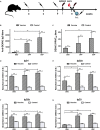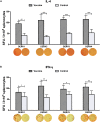Vaccination With a Single Consensus Envelope Protein Ectodomain Sequence Administered in a Heterologous Regimen Induces Tetravalent Immune Responses and Protection Against Dengue Viruses in Mice
- PMID: 31134046
- PMCID: PMC6524413
- DOI: 10.3389/fmicb.2019.01113
Vaccination With a Single Consensus Envelope Protein Ectodomain Sequence Administered in a Heterologous Regimen Induces Tetravalent Immune Responses and Protection Against Dengue Viruses in Mice
Abstract
The development of a safe and effective tetravalent dengue vaccine that elicits protection against all dengue virus (DENV) serotypes is urgently needed. The consensus sequence of the ectodomain of envelope (E) protein of DENV (cE80) has been examined as an immunogen previously. In the current study, a cE80 DNA (D) vaccine was constructed and evaluated in conjunction with the cE80 protein (P) vaccine to examine whether both vaccines used together can further improve the immune responses. The cE80 DNA vaccine was administrated using either a homologous (DNA alone, DDD) or heterologous (DNA prime-protein boost: DDP or DPP) regimen, and evaluated for immunogenicity and protective efficacy in mice. Among the three DNA-based immunization regimens tested, DDP immunization is the optimal immunization regimen that elicited the greatest systemic immune response and conferred protection against all four DENV serotypes. This work provides innovative ideas for the development of consensus E-based dengue vaccines and the testing of optimal immunization regimens.
Keywords: E80; consensus sequence; dengue virus; envelope; prime-boost; tetravalent vaccine.
Figures






Similar articles
-
Elaboration of tetravalent antibody responses against dengue viruses using a subunit vaccine comprised of a single consensus dengue envelope sequence.Vaccine. 2017 Nov 1;35(46):6308-6320. doi: 10.1016/j.vaccine.2017.09.063. Epub 2017 Oct 4. Vaccine. 2017. PMID: 28987441
-
The Immunodominance Change and Protection of CD4+ T-Cell Responses Elicited by an Envelope Protein Domain III-Based Tetravalent Dengue Vaccine in Mice.PLoS One. 2015 Dec 29;10(12):e0145717. doi: 10.1371/journal.pone.0145717. eCollection 2015. PLoS One. 2015. PMID: 26714037 Free PMC article.
-
An Envelope-Modified Tetravalent Dengue Virus-Like-Particle Vaccine Has Implications for Flavivirus Vaccine Design.J Virol. 2017 Nov 14;91(23):e01181-17. doi: 10.1128/JVI.01181-17. Print 2017 Dec 1. J Virol. 2017. PMID: 28956764 Free PMC article.
-
From research to phase III: preclinical, industrial and clinical development of the Sanofi Pasteur tetravalent dengue vaccine.Vaccine. 2011 Sep 23;29(42):7229-41. doi: 10.1016/j.vaccine.2011.06.094. Epub 2011 Jul 13. Vaccine. 2011. PMID: 21745521 Review.
-
Does structurally-mature dengue virion matter in vaccine preparation in post-Dengvaxia era?Hum Vaccin Immunother. 2019;15(10):2328-2336. doi: 10.1080/21645515.2019.1643676. Epub 2019 Aug 23. Hum Vaccin Immunother. 2019. PMID: 31314657 Free PMC article. Review.
Cited by
-
Dengue Virus and Vaccines: How Can DNA Immunization Contribute to This Challenge?Front Med Technol. 2021 Apr 12;3:640964. doi: 10.3389/fmedt.2021.640964. eCollection 2021. Front Med Technol. 2021. PMID: 35047911 Free PMC article. Review.
-
Defeat Dengue and Zika Viruses With a One-Two Punch of Vaccine and Vector Blockade.Front Microbiol. 2020 Mar 20;11:362. doi: 10.3389/fmicb.2020.00362. eCollection 2020. Front Microbiol. 2020. PMID: 32265852 Free PMC article. Review.
-
Dengue mouse models for evaluating pathogenesis and countermeasures.Curr Opin Virol. 2020 Aug;43:50-58. doi: 10.1016/j.coviro.2020.09.001. Epub 2020 Sep 17. Curr Opin Virol. 2020. PMID: 32950933 Free PMC article. Review.
-
The Adjuvant Activity of BCG Cell Wall Cytoskeleton on a Dengue Virus-2 Subunit Vaccine.Vaccines (Basel). 2023 Aug 9;11(8):1344. doi: 10.3390/vaccines11081344. Vaccines (Basel). 2023. PMID: 37631912 Free PMC article.
-
Long-term protection against dengue viruses in mice conferred by a tetravalent DNA vaccine candidate.Zool Res. 2020 Jan 18;41(1):90-93. doi: 10.24272/j.issn.2095-8137.2020.016. Zool Res. 2020. PMID: 31746566 Free PMC article.
References
-
- Beltramello M., Williams K. L., Simmons C. P., Macagno A., Simonelli L., Quyen N. T., et al. (2010). The human immune response to Dengue virus is dominated by highly cross-reactive antibodies endowed with neutralizing and enhancing activity. Cell Host Microbe 8 271–283. 10.1016/j.chom.2010.08.007 - DOI - PMC - PubMed
-
- Cao W., Mishina M., Amoah S., Mboko W. P., Bohannon C., McCoy J., et al. (2018). Nasal delivery of H5N1 avian influenza vaccine formulated with GenJet or in vivo-jetPEI((R)) induces enhanced serological, cellular and protective immune responses. Drug Deliv. 25 773–779. 10.1080/10717544.2018.1450909 - DOI - PMC - PubMed
LinkOut - more resources
Full Text Sources
Research Materials

